


Application
The Fixing-Plate has many application areas for framing work. It can be adapted to every situation, for paintings on canvas, canvas panels, graphic art or mounting a back surface protection. The Fixing-Plate can be bent with flat tongs or the Fixing-Plate Tongs, an accessory developed for the Fixing-Plate. The success of the Fixing-Plate arises from its unique sprung steel and the well-designed hole pattern which enables it to be mounted as required on artworks and frames.
Target Group
The Fixing-Plate has been developed for framing work and has been used since its introduction in 1982 by both museums and framers.
Description
The material in the Fixing-Plate is a hardened sprung steel which, even after reforming, retains its strong sprung capabilities. Other framing brackets lack this property, and are difficult to reshape. The Fixing-Plate's hole pattern, two elongated holes, makes it possible to mount the Fixing-Plate close to the artwork without damaging its edges, as well as making it easy to adapt the framing to the artwork. The colour of the Fixing-Plate is blue-black.
Sizes
The Fixing-Plate is offered in three different sizes.
| Size Measurement | Large | Medium | Small |
|---|---|---|---|
| Length (mm.) | 100 | 70 | 55 |
| Width (mm.) | 19 | 19 | 12,7 |

Delivery
The Fixing-Plate is delivered in packages of 100 bracket units and 100 Temart screws 3,0 x 10,0 mm I, a resealable package.
Accessories
Fixing-plate tongs
The Fixing-Plate Tongs were constructed to reshape the Fixing-Plate in the optimum angle to exploit the Fixing-Plate's characteristics: strength and flexibility. The Fixing-Plate Tongs can also be used for other brackets used in framing work. The Fixing-Plate Tongs simplify work when framing large quantities of artwork.

Instruction for use
Hold the Fixing-Plate Tongs so that the movable
head points upwards. Place the Fixing-Plate towards the two
protrustions at the front edge of the lower jaw of the
Fixing-Plate Tongs. Place the Fixing-Plate so that it folds
at the required place. Note that the elongated hole must lie
against the artwork frame's back surface.
There are two ways
to measure the distance to the other angle:
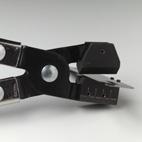
Recessed mounting
Use the engraved millimetre scale on the Fixing-Plate Tongs by placing the Fixing-Plate Tongs on the short side of the jaws and measuring the height. Transfer the measurement to the Fixing-Plate.
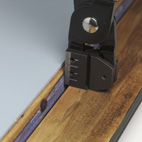
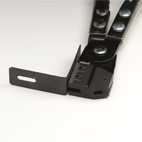
Raised mounting
Place the bent Fixing-Plate on the artwork frame with the elongated hole against the frame's back surface. Mark the required height with a screwdriver. Now turn the Fixing-Plate, lay it on the protrustions and press against the marked point with the wedge-shaped jaw. The Fixing-Plate is now ready to mount. A stronger spring can be achieved by leaving the Fixing-Plate in the Fixing-Plate Tongs and then pressing down with the thumb on the Fixing-Plate in the direction in which the spring pressure is to lie.
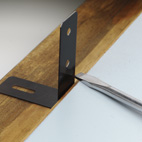
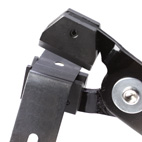
Mounting
Lay the Fixing-Plate against the artwork. If necessary, protective felt pieces can be placed between the artwork and the Fixing-Plate. Screw the Fixing-Plate tight in the elongated hole. The screw should be placed as far out as possible. With this mounting, the artwork can be removed when the Fixing-Plate is rotated through 90 degrees. The Fixing-Plate must not be completely removed when unframing. Loosening the screws one turn is sufficient.
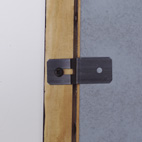
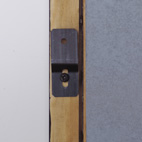
Summary
| Art. Nr. | Product | Suitable screw |
|---|---|---|
| 50-400 | Fixing-plate Small | 51-001, 52-001, 53-001 |
| 50-500 | Fixing-plate Medium | 54-001, 56-001 |
| 50-600 | Fixing-plate Large | 54-001, 56-001 |
| 50-900 | Fixing-plate Tong |